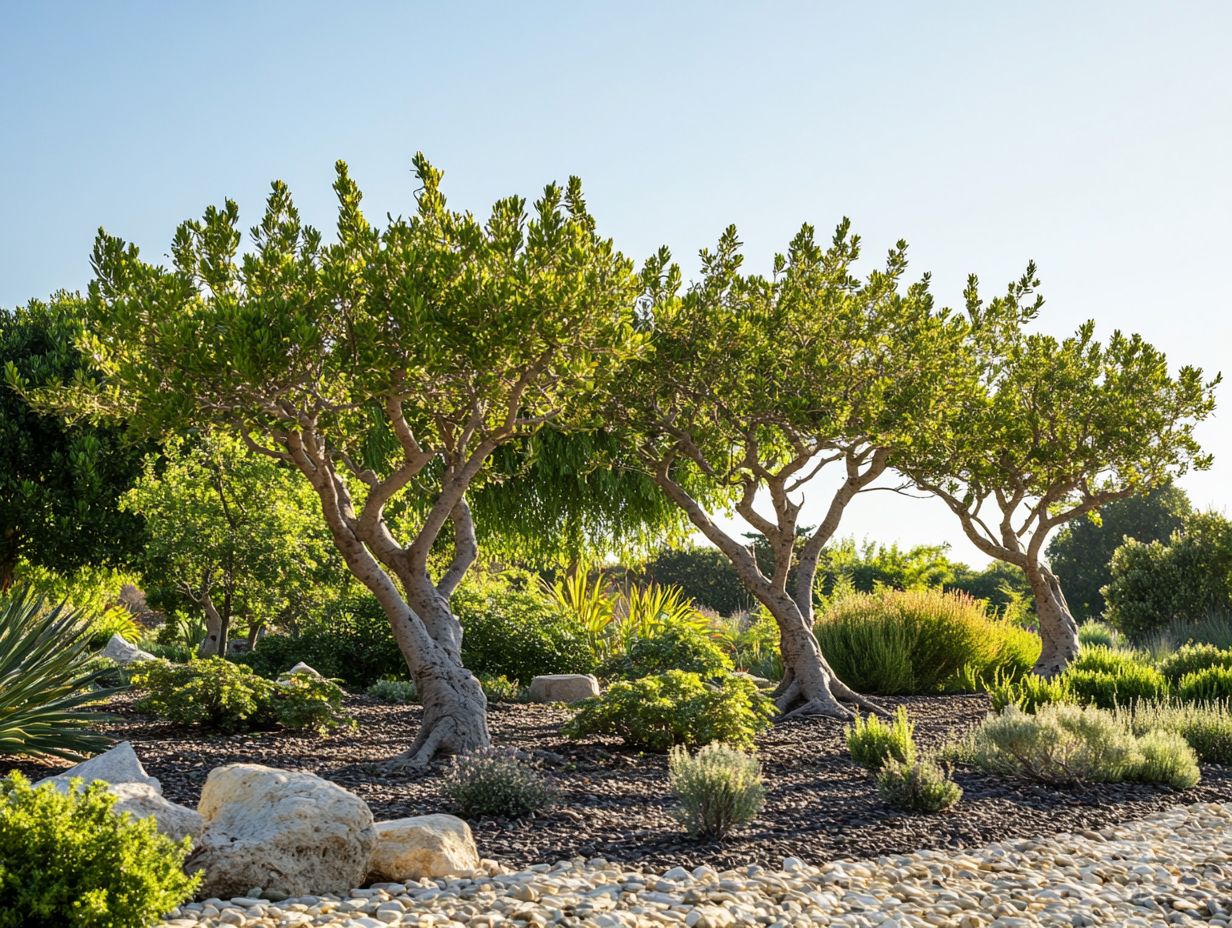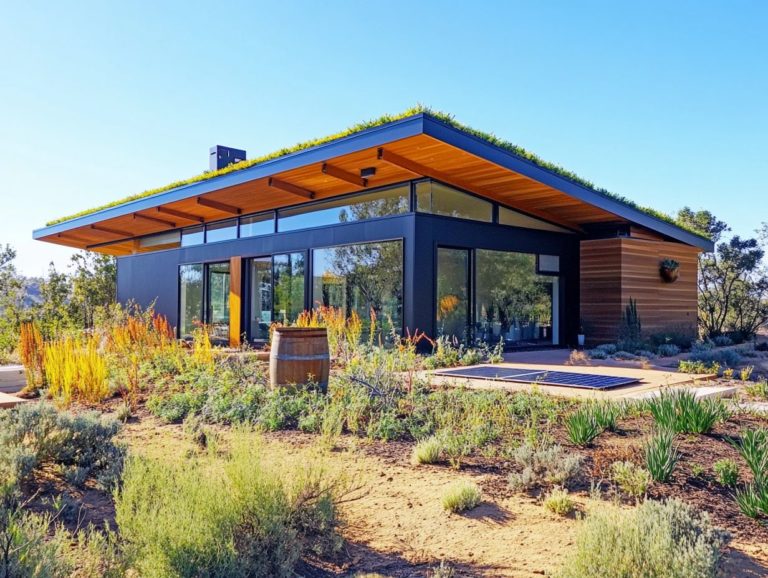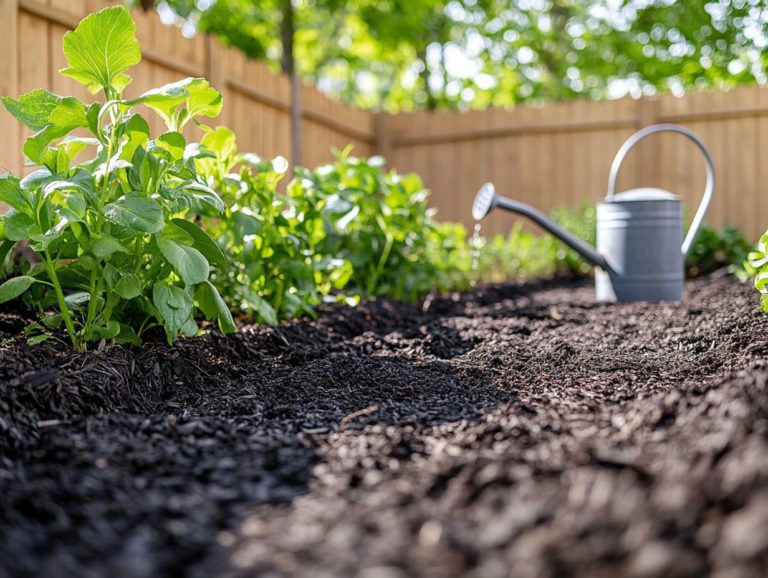5 Drought-Resistant Trees for Your Landscape
In a time when water conservation is paramount, integrating drought-resistant trees into your landscape can significantly impact your environment. These hardy trees not only thrive in arid conditions but also elevate the beauty and value of your outdoor space.
From the striking Crape Myrtle to the sophisticated Redbud, explore five remarkable trees that can endure dry spells while adding charm to your garden. Delve into the care these trees require, their numerous benefits, and the common missteps to avoid as you adopt a more sustainable landscaping approach.
Contents
- Key Takeaways:
- 1. Crape Myrtle
- 2. Desert Willow
- 3. Palo Verde
- 4. Olive Trees
- 5. Redbud Trees
- What Makes These Trees Drought-Resistant?
- Frequently Asked Questions
- What are the top 5 drought-resistant trees for my landscape, including Palo Verde and Crepe Myrtle?
- Why should I choose drought-resistant trees for my landscape?
- Are drought-resistant trees suitable for all climates?
- Do drought-resistant trees attract pests or diseases?
- How can I ensure the success of my drought-resistant trees in my landscape?
- Can I plant other plants or shrubs under my drought-resistant trees?
Key Takeaways:

- Choose drought-resistant trees like Crape Myrtle, Desert Willow, Palo Verde, and Olive trees. They add beauty and are excellent for dry conditions.
- These trees need less water and can thrive in hot and dry climates, making them a practical and good for the environment addition to your yard.
- To ensure the best care for these trees, provide adequate drainage, mulch, and regular pruning to promote healthy growth and conserve water in your landscape.
1. Crape Myrtle
The Crape Myrtle is a spectacular choice for any garden, particularly in warm climates where drought-tolerant trees like the Kentucky coffeetree excel. It features vibrant blooms that continue often into the fall, creating a captivating display.
This remarkable tree typically grows between 4 to 30 feet tall and spreads 3 to 25 feet wide, adapting to various spaces. Thriving in USDA hardiness zones 7 to 9, the Crape Myrtle flourishes in warm, sunny environments and has become a favorite among gardeners for its long-lasting blooms.
Beyond its ornamental charm, the Crape Myrtle plays an essential role in supporting local wildlife, attracting native birds and pollinators like bees and butterflies. It provides vital food sources and habitats, enhancing the beauty of your outdoor spaces while supporting local ecosystems.
2. Desert Willow
Desert Willow is a truly remarkable tree, celebrated for its drought resilience and low-maintenance needs. Thriving effortlessly in warm climates, it decorates your landscape with lush greenery and sweet-smelling flowers that attract native wildlife.
Reaching a mature height of up to 30 feet with a generous spread of 15 to 25 feet, this tree doesn t just provide ample shade; it also elevates the visual appeal of any setting. Its elongated, willow-like leaves sway gracefully in the breeze, adding an elegant touch and a sense of movement to even the toughest garden environments.
Perfectly suited for wildlife gardens, Desert Willow creates a haven for hummingbirds and butterflies, making it an ideal choice for environmentally conscious gardeners. The stunning blooms, ranging from lavender to creamy white, blend seamlessly with other hardy plants, enhancing the beauty of a resilient landscape.
3. Palo Verde
The Palo Verde tree is a premier choice for anyone looking to enhance their landscape with resilience and beauty! Its drought tolerance allows it to flourish in low-water conditions and provides a welcoming habitat for various wildlife in your backyard garden.
With striking green bark and delicate yellow flowers, this tree typically reaches heights of 15 to 30 feet and spreads about 25 to 35 feet wide. Its impressive deep root system taps into moisture deep below the surface, making it a stellar performer in challenging garden environments.
The Palo Verde tree also plays a crucial role in local ecosystems by attracting bees and other pollinators. It enhances the aesthetic appeal of your landscape while contributing significantly to biodiversity.
4. Olive Trees

Olive trees are a timeless addition to your landscape! They offer beauty and drought tolerance, thriving in warm climates while requiring minimal maintenance.
These trees reach a mature height of approximately 10 to 30 feet, spreading just as wide. Their evergreen foliage provides year-round interest, making them a favorite among landscape enthusiasts.
With the ability to thrive in challenging soil conditions, olive trees become the cornerstone for low-maintenance yards. They attract bees, birds, and other beneficial creatures, while their gnarled trunks and silvery leaves add undeniable charm!
5. Redbud Trees
Redbud trees add a distinctive charm to your garden with their striking spring blooms and mesmerizing fall colors. Their drought-tolerant nature allows them to thrive effortlessly in low-maintenance yards while providing vital habitats for native wildlife.
These deciduous beauties typically grow to a height of 20 to 30 feet, spreading 25 to 35 feet wide. They create an impressive canopy adorned with heart-shaped leaves.
In early spring, enchanting pink to purple flowers burst forth, offering a vibrant splash of color that beckons pollinators like bees and butterflies. As autumn approaches, their foliage transforms into a delightful shade of yellow, extending the visual appeal of your garden throughout the seasons.
The importance of redbuds in wildlife gardens is unparalleled. They serve as essential nesting sites and food sources for various species, enhancing your garden’s resilience by fostering a thriving ecosystem.
What Makes These Trees Drought-Resistant?
Drought-resistant trees, like the ones you’ll explore here, are remarkable for their ability to thrive in limited rainfall. For inspiration, check out these unique drought-tolerant design ideas. Thanks to their deep roots, they efficiently access moisture and nutrients across various hardiness zones.
These trees often develop extensive root systems that plunge deep into the earth, seeking hidden water sources while stabilizing the soil and curbing erosion. Their remarkable adaptability allows them to flourish in nutrient-poor conditions, utilizing fungal relationships to enhance nutrient uptake.
In hotter climates, these adaptations are essential for maintaining health. These trees typically feature smaller, waxy leaves that minimize transpiration, conserving precious water while ensuring effective photosynthesis.
Such characteristics position them as vital components of their ecosystems, supporting local wildlife while contributing to carbon cycles, even in arid regions!
How Can These Trees Benefit Your Landscape?
Incorporating drought-tolerant trees into your landscape brings numerous benefits. You’ll reduce water usage, create low-maintenance yards, and enhance aesthetics while fostering vibrant wildlife gardens. For inspiration, check out these must-visit drought-tolerant landscapes.
These trees thrive in dry conditions and are among the 7 drought-resistant plants for low maintenance. They help maintain soil moisture and minimize runoff, preventing erosion and promoting healthier landscapes.
With their attractive foliage and unique structures, these trees elevate your garden’s visual appeal. This makes it an inviting space for relaxation and enjoyment.
They provide essential habitats for wildlife, from birds to beneficial insects. By integrating drought-tolerant trees, you nurture a thriving environment that supports community biodiversity.
What Are the Best Ways to Care for These Trees?

Caring for drought-tolerant trees requires understanding their unique soil needs and proper pruning techniques. This ensures they stay healthy and vibrant while keeping your yard low-maintenance.
To help these trees flourish, establish a consistent watering schedule, especially during their early growth. Using natural materials that improve soil quality can enhance drainage and nutrient availability.
Don’t overlook seasonal maintenance. Regularly check for pests and diseases, and apply mulch to retain soil moisture. Prune to shape the tree and remove dead branches for better airflow.
Monitor soil conditions, including pH and moisture levels. This is vital for long-term health and vitality.
What Are Some Other Drought-Resistant Tree Options?
You have many drought-tolerant tree options, including drought-resistant trees for urban areas, each thriving in challenging conditions. This opens up possibilities for enhancing your landscape while supporting native wildlife.
Consider the Kentucky coffeetree. Its unique shape and vibrant fall color make it a standout choice. It thrives in dry, well-drained areas, perfect for water conservation.
The Golden Rain Tree is another fantastic option. Its bright yellow flowers and attractive seed pods bring color to your garden while providing food for birds.
The Eastern Red Cedar offers year-round shelter for small birds and withstands drought well. These trees enhance your landscape and attract diverse wildlife.
How Can These Trees Help Conserve Water in Your Landscape?
Drought-tolerant trees are essential for conserving water in your landscape. Incorporating the best drought-resistant shrubs for landscaping can further enhance your yard, as they require less moisture and help create a low-maintenance yard, reducing the need for frequent irrigation and upkeep.
These remarkable trees typically boast extensive root systems that delve deep into the ground, accessing moisture that shallow-rooted species simply can t reach. Their leaves may also feature adaptations, like waxy coatings or reduced surface areas, which minimize water loss.
By incorporating these resilient varieties into both urban and rural landscapes, you can significantly improve water resource management. This approach reduces your reliance on city water, fosters healthier ecosystems, and supports biodiversity. It also helps mitigate the effects of climate change, making it a smart choice for sustainable land stewardship.
What Are Some Common Mistakes to Avoid When Planting Drought-Resistant Trees?
When planting drought-tolerant trees, common missteps can undermine their growth and effectiveness. Think poor soil prep, inadequate watering, and neglecting the vital art of pruning to shape and support their development.
These pitfalls can lead to stunted growth, weak root systems, and ultimately, a tree that just doesn’t thrive in its environment. To avoid these issues, first assess the good soil, ensuring it drains well and is enriched with the right amendments.
Water management is crucial; these trees thrive with less frequent watering but require deeper soaking to encourage strong roots. Research each species’ mature height and spread to plan ample space for growth and prevent overcrowding.
By following these strategies, you can cultivate a healthy, drought-resistant landscape that will endure through the years.
Frequently Asked Questions

What are the top 5 drought-resistant trees for my landscape, including Palo Verde and Crepe Myrtle?
The top 5 drought-resistant trees for urban areas are mesquite, desert willow, Palo Verde, Olive, and Chinese pistache.
Why should I choose drought-resistant trees for my landscape?
Choose drought-resistant trees to save water and cut down on maintenance!
Are drought-resistant trees suitable for all climates?
While most drought-resistant trees thrive in hot and dry climates, some varieties can tolerate colder climates as well. For those interested in gardening, consider exploring edible drought-resistant plants to grow.
Do drought-resistant trees attract pests or diseases?
Drought-resistant trees are generally more resilient and less prone to pests and diseases, as they are better adapted to withstand harsh conditions. For those looking to enhance their gardens, consider these tips for choosing drought-resistant plants.
How can I ensure the success of my drought-resistant trees in my landscape?
Proper planting and regular watering during the first few years are crucial for establishing drought-resistant trees. Applying mulch around the tree bases helps retain moisture.
Can I plant other plants or shrubs under my drought-resistant trees?
Yes, you can plant other drought-resistant plants or shrubs under your drought-resistant trees, provided they have similar water and sunlight requirements.






